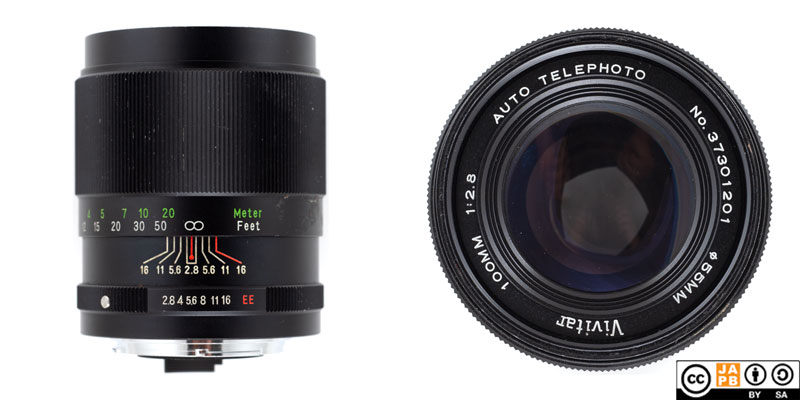Pekka Buttler, 03/2024

Specifications
The table below summarizes the lens’ key specifications (measurements based on pictured, last version of the lens):
| Brand: | Vivitar | Lens name | 100MM 1:2.8 auto telephoto |
| Focal length(s)1 | 100 mm | Angle-of-view2 | 24° |
| Maximum Aperture | f/2.8 | In Production | unclear3 |
| Lens mount (this lens) | Konica AR | Other lens mounts | multiple4 |
| Length5 | 76,0 mm | Diameter6 | 64,8 mm |
| Filter ring diameter | 55 mm | Weight | 379 grams |
| Lens element count | unclear7 | Lens group count | unclear |
| Aperture blades (S/R/C)8 | 5 S | Focus throw | 190 ° |
| Minimum focusing distance | 1,4 m | Maximum magnification | ≈1:10 |
| Has manual aperture ring | YES | Has Manual focus ring | YES |
| Aperture mechanism type | Automatic | Aperture click stops 9 | 2.8-4-5.6-8-11-16 |
Further notes:
• This lens is a bit of an odd duck, on several counts.
• Firstly, most Vivitar 100 mm lenses were macro lenses, but this lens is decidedly not macro (it actually has a fairly long MFD).
• Second, it is clearly a Tokina-made lens and it has a fixed mount, but it hails from an era when Tokina’s primary focus (and Vivitar’s primary interest in Tokina) was based on using intermediate mounts, such as the T-4 and later the TX intermediate mount.
• Tokina also manufactured a series of lenses for Vivitar that also had a fixed (not intermediate) mount, but that was much later and this later series of lenses was characterised by diamond-pattern rubber focus rings.
• It would also seem that there was another 100 mm f/2.8 Vivitar lens with a smilar all-metal build and lengthwise ribbed focusing rings, but its origins are unclear as it does not adhere to Vivitar’s serial numbering scheme (which also means that it likely is an earlier lens)
• This series of Tokina lenses for Vivitar (with metal, ribbed focus rings and a fixed mount) seems to be relatively rare.
Versions and variations
While Vivitar seems to have sold a number of different 100 mm lenses with an f/2.8 maximum aperture, none of those other lenses seem to be related to this lens in any meaningful way. Moreover, I have found no indication that Tokina would ever have sold this design under its own brand, nor to any other rebrander. Furthermore, I have not found any indication of more than one cosmetic version of this lens (but considering that I have only seen a dozen samples, that is not saying much).
However, this Vivitar/Tokina 100 mm f/2.8 was offered for a broad range of lens mounts, which in itself leads to some variation (with the difference in flange focal differences ranging from 40,5 mm to 46,5 mm). Hence the length of the Vivitar 100 mm f/2.8 will vary somewhat based on which lens mount it has, and the different lens mounts will unavoidably also lead to some cosmetic differences.
History of Vivitar
Vivitar initially was the trade name used by Ponder & Best Inc. until Ponder & Best changed its name to Vivitar Corp. From the 1960s to the early 2000s the company contracted various (mostly Japanese) optical and electronics manufacturers to manufacture photographic gear to be branded as Vivitar.
You can read more details in the Vivitar company profile.
Adapting
n.B! The following applies to all Konica AR mount lenses.
This lens cannot be used natively on any current SLR or dSLRs. To use it in its native environment, you will need a Konica AR-mount film body.
Thanks to being a fully manual lens (manual aperture, manual focus), the lens can be adapted to all mirrorless cameras using a suitable adapter. Moreover, Konica AR lenses are so uncomplicated that a simple ‘dumb adapter’ will do the job perfectly. However, due to Konica AR lenses not being among the most numerously manufactured, special adapters (helicoid adapters, tilt/shift adapters) are not easy to come by and speed boosters are currently unavailable.
Using Konica AR lenses on dSLRs is possible, but difficult. Due to the exceptionally short flange focal distance of the Konica AR mount (at 40,5 mm, a lot shorter than that of any full-frame dSLR mount), any adapter will necessitate some optics to achieve anything near infinity focus.
Footnotes
- Focal length is (unless stated otherwise) given in absolute terms, and not in Full-frame equivalent. For an understanding of whether the lens is wide/tele, see ‘Angle-of-view’. ↩︎
- Picture angle is given in degrees (based on manufacturers’ specs) and concerns the diagonal picture angle. Rule of thumb:
> 90 ° ==> Ultra-wide-angle
70–90 ° ==> Wide-angle
50–70 ° ==> Moderate wide-angle
40–50 ° ==> ‘Standard’ or ‘normal’ lens
20–40 ° ==> Short tele lens
10-20 ° ==> Tele lens
5-10 ° ==> Long tele lens
< 5 ° ==> Ultra-tele lens ↩︎ - Existing information is conflicting, likely introduced 1970. Pictured sample from 1973. ↩︎
- Including: Canon FD, Contax/Yashica, Konica AR, M42, Minolta SR, Nikon F, Olympus OM and Pentax K ↩︎
- Length is given from the mount flange to the front of lens at infinity. ↩︎
- Diameter excludes protrusions such as rabbit ears or stop-down levers. ↩︎
- Online sources offer conflicting data. Some mention a 5 elements in 3 groups design, others a 5 elements in 4 groups design. There is also variation in number of aperture blades (many sources mention 8 blades, but the pictured sample clearly has 5 blades. ↩︎
- S=straight; R=rounded; C=(almost)circular at all apertures. ↩︎
- Numbers equal aperture values on aperture ring; • intermediate click; – no intermediate click. ↩︎